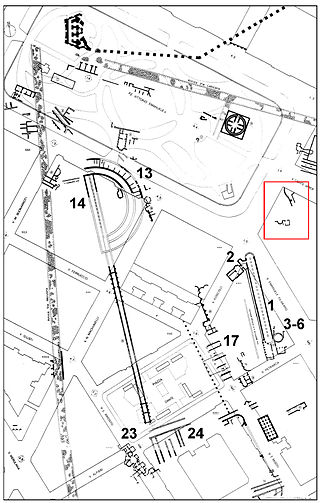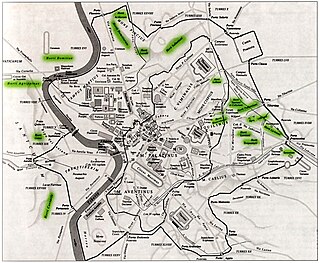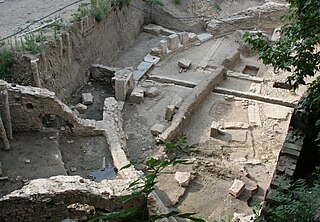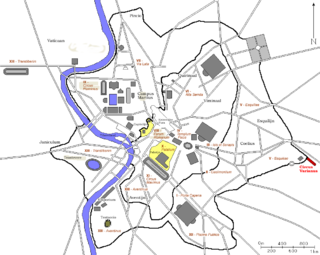
The Colosseum is an elliptical amphitheatre in the centre of the city of Rome, Italy, just east of the Roman Forum. It is the largest ancient amphitheatre ever built, and is still the largest standing amphitheatre in the world, despite its age. Construction began under the emperor Vespasian in 72 and was completed in AD 80 under his successor and heir, Titus. Further modifications were made during the reign of Domitian. The three emperors who were patrons of the work are known as the Flavian dynasty, and the amphitheatre was named the Flavian Amphitheatre by later classicists and archaeologists for its association with their family name (Flavius).

Ancient Roman architecture adopted the external language of classical ancient Greek architecture for the purposes of the ancient Romans, but was different from Greek buildings, becoming a new architectural style. The two styles are often considered one body of classical architecture. Roman architecture flourished in the Roman Republic and to an even greater extent under the Empire, when the great majority of surviving buildings were constructed. It used new materials, particularly Roman concrete, and newer technologies such as the arch and the dome to make buildings that were typically strong and well engineered. Large numbers remain in some form across the former empire, sometimes complete and still in use today.

The Palatine Hill, which relative to the seven hills of Rome is the centremost, is one of the most ancient parts of the city; it has been called "the first nucleus of the Roman Empire". The site is now mainly a large open-air museum whilst the Palatine Museum houses many finds from the excavations here and from other ancient Italian sites.

The Domus Aurea was a vast landscaped complex built by the Emperor Nero largely on the Oppian Hill in the heart of ancient Rome after the great fire in 64 AD had destroyed a large part of the city.

Mediolanum, the ancient city where Milan now stands, was originally an Insubrian city, but afterwards became an important Roman city in Northern Italy.

The Baths of Diocletian were public baths in ancient Rome. Named after emperor Diocletian and built from AD 298 to 306, they were the largest of the imperial baths. The project was originally commissioned by Maximian upon his return to Rome in the autumn of 298 and was continued after his and Diocletian's abdication under Constantius, father of Constantine.

The Aurelian Walls are a line of city walls built between 271 AD and 275 AD in Rome, Italy, during the reign of the Roman Emperor Aurelian. They superseded the earlier Servian Wall built during the 4th century BC.

Esquilino is the 15th rione, or administrative division, of Rome, identified by the initials R. XV, and is Located within the Municipio I. It is named after the Esquiline Hill, one of the Seven Hills of Rome.

The Gardens of Sallust was an ancient Roman estate including a landscaped pleasure garden developed by the historian Sallust in the 1st century BC. It occupied a large area in the northeastern sector of Rome, in what would become Region VI, between the Pincian and Quirinal hills, near the Via Salaria and later Porta Salaria. The modern rione is now known as Sallustiano.

The Colossus of Nero was a 30-metre (98 ft) bronze statue that the Emperor Nero created in the vestibule of his Domus Aurea, the imperial villa complex which spanned a large area from the north side of the Palatine Hill, across the Velian ridge to the Esquiline Hill. It was modified by Nero's successors into a statue of the sun god Sol. The statue was eventually moved to a spot outside the Flavian Amphitheatre, which became known, by its proximity to the Colossus, as the Colosseum.

The Gardens of Maecenas, or Horti Maecenatis, constituted the luxurious ancient Roman estate of Gaius Maecenas, an Augustan-era imperial advisor and patron of the arts. The property was among the first in Italy to emulate the style of Persian gardens. The walled villa, buildings, and gardens were located on the Esquiline Hill, atop the agger of the Servian Wall and its adjoining necropolis, as well as near the Horti Lamiani.

The Horti Lamiani was a luxurious complex consisting of an ancient Roman villa with large gardens and outdoor rooms. It was located on the Esquiline Hill in Rome, in the area around the present Piazza Vittorio Emanuele. The horti were created by the consul Lucius Aelius Lamia, a friend of Emperor Tiberius, and they soon became imperial property. They are of exceptional historical-topographical importance. Along with other ancient Roman horti on the Quirinal, Viminal and Esquiline hills, they were discovered during the construction work for the expansion of Rome at the end of 1800s.

The Horti Liciniani was a luxurious complex of an ancient Roman villa with large gardens and outdoor rooms originally belonging to the gens Licinia. It was located in Rome on the Esquiline Hill between via Labicana and via Prenestina, close to the Aurelian walls. They bordered the Horti Tauriani to the north and the Horti Pallantiani and Horti Epaphroditiani to the west.

The Amphitheatre of Serdica was an amphitheatre in the Ancient Roman city of Ulpia Serdica, now Sofia, the capital of Bulgaria. Discovered in 2004 and the subject of excavations in 2005 and 2006, the ruins of the amphitheatre lie on two adjacent sites in the centre of modern Sofia. The amphitheatre was built in the 3rd–4th century AD on top of a 2nd–3rd century theatre, which had been ravaged by the Goths. However, the amphitheatre remained in use for less than a century and was abandoned by the 5th century.

Circeii was an ancient Roman city on the site of modern San Felice Circeo and near Mount Circeo, the mountain promontory on the southwest coast of Italy. The area around Circeii and Mount Circeo was thickly populated with Roman villas and other buildings, of which the remains of many can still be seen.

Roman amphitheatres are theatres — large, circular or oval open-air venues with raised seating — built by the ancient Romans. They were used for events such as gladiator combats, venationes and executions. About 230 Roman amphitheatres have been found across the area of the Roman Empire. Early amphitheatres date from the Republican period, though they became more monumental during the Imperial era.
Hazel Dodge is senior Lecturer of Roman Archaeology at Trinity College, Dublin. She holds her degrees from the University of Newcastle-Upon-Tyne and her research interests include the Eastern Roman Empire, the Roman construction industry and the city of Rome. Her PhD concerns the use and distribution of marble from the Eastern Empire. She has published extensively on Roman archaeology often in collaboration with colleagues such as Peter Connolly and Jon Coulston to whom she is married. One of her most notable publications is "the Archaeology of the City of Rome" and most recently she has published a volume on spectacle in the Roman World for Bristol Classical Press. A new source book on Rome with Jon Coulston and Christopher Smith is forthcoming. In 2010/11 she was a guest lecturer with the Archaeological Institute of America.

Circus Varianus was a large Roman circus, started during the reign of Caracalla and located in the palatial villa complex known as the Horti Spei Veteris, which included the Amphitheatrum Castrense. This circus was where Elagabalus raced chariots under the family name of Varius, giving the site its name. The circus was later restructured by Elagabalus, who removed the western end to create more space for the palace by moving the starting gates (carcares) back and building two towers at the end.

The Horti Spei Veteris, later called Horti Variani, was a luxurious and important palace-estate, eventually the residence of Emperors, on the Esquiline Hill at the south eastern corner of ancient Rome and covering an area of 12,000 m2.




















